What Is Farro—and How Do You Cook With It?
Learn all about the healthy grain.
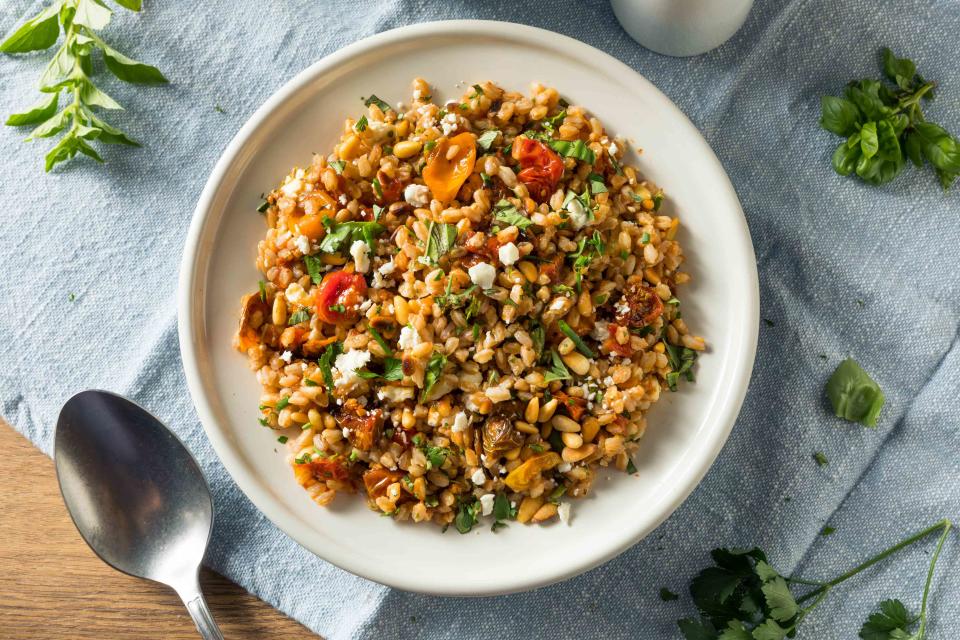
bhofack2 / Getty Images
Farro is on the rise, thanks to its versatility, pleasantly chewy texture, and nutritional benefits. But what is farro, exactly? It’s a grain that looks like a hybrid of rice and barley, can be subbed into numerous recipes, and ground into flour for an earthy, fiber-rich baking ingredient. If you haven’t heard of farro, you’ve been missing out on just a few thousand years of flavor.
“Considered an ancient wheat grain variety, dating back 10,000 years, farro originated in the Fertile Crescent, a crescent-shaped region in Western Asia formed by the Tigris and Euphrates rivers and the Mediterranean Sea, and was named after the Pharaohs of Egypt,” explains Debbie La Bell, sales and marketing strategist at Hayden Flour Mills.
Similar to other whole grains, farro is encased in a tough outer shell, or hull, and is naturally low in gluten and high in protein, with a nutty flavor and satisfying texture. Here’s everything you need to know about farro to move beyond basic grains, and start incorporating farro in your home cooking.
Related: The Best Grain Types to Add to Your Weekly Meal Rotation
What Is Farro?
“Farro is a grain similar to wheat, traditionally made from spelt, emmer, or einkorn,” says Sarah House, Food Innovation Chef at Bob’s Red Mill. “Farro has a very pleasant, slightly nutty, grain flavor. It pairs well with a myriad of other flavors [including] vegetables, fruits, and spices.”
Farro is unique because it can be served in so many different ways: Soups, pilafs, salads, grain bowls, hot cereal, veggie burgers, chili, and risotto all work with farro, affirms House. “The cooked grains can be added to breads and even desserts,” she says.
And not all farro is created equal. ”Farro can be produced from three wheat relatives: spelt, emmer, and einkorn,” House notes. “The biggest difference in the three varieties of farro is the individual grain size.”
Farro comes in pearled, semi-pearled, and whole farro varieties. “Whole farro means the entire grain is intact; semi-pearled is akin to lightly scratching the surface creating small scores in the bran; pearled grains have all or most of the outer bran layer removed,” says House. “Pearled grains will have the shortest cook time and a soft texture perfect for soups and risotto-style dishes, anytime you want a lot of creamy starch. Whole farro takes the longest to cook, and is best used in salads and grain bowls—dishes when the grains should be separate and distinct. Semi-pearled is an all-purpose farro and works well in all dishes.”
Is Farro Gluten-Free?
No, farro is not gluten-free. Farro is an ancient grain related to wheat, which contains gluten.
Nutritional Benefits of Farro
Farro has many nutritional benefits. “Nutritionally, farro is a good source of fiber (offering about 18 percent of the daily value) and iron,” says House. “It also contains 6 grams of protein per serving. Compared to brown rice, farro is higher in fiber and protein, and farro has more fiber than quinoa.”
Related: The 8 Best Sources of Protein Eat ASAP
Farro is also rich in magnesium, and consuming farro can be beneficial to heart health, brain health, and beyond.
How to Cook Farro
Farro is easy to prepare in a variety of ways. “Preparing the basic farro grains is very simple. The pasta method is foolproof,” House says. That is, cooking farro like pasta can easily yield tasty results. To do so, bring a large pot of salted water to boil. Add farro and cook uncovered until soft, about 30 minutes.
“Farro is also great in the slow cooker and multi-cooker,” House adds. “For an even shorter cook time, farro can be soaked overnight before draining and cooking the farro in new water.” Farro can also be cooked in broth or other liquids.
Cooked farro can be kept in an airtight food storage container in the refrigerator for up to five days. Farro can also be frozen in a single layer on a sheet pan and packed into airtight containers or bags to keep in the freezer for easy use.
Farro Recipes
Now that you know all about farro and how to cook it, it’s time to try it out with these delicious farro recipes.
Warm Browned Butter Farro Salad
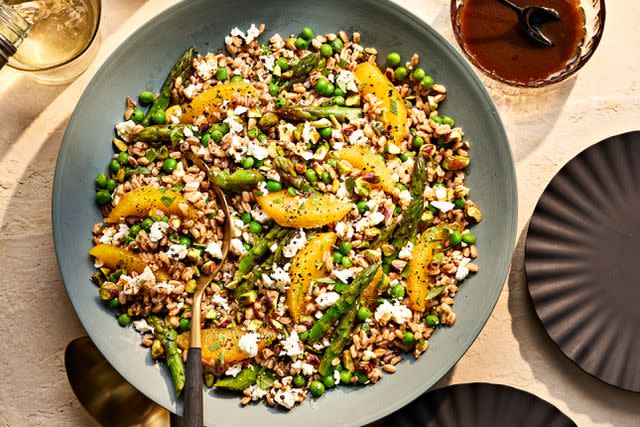
Victor Protasio
Any salad with butter is a winner. This farro-based salad combines asparagus, peas, pistachios, and feta for a bright, springtime flavor, but the dressing and technique can be applied any time of year. Roasted squash, sweet potatoes, or greens could easily swap into this concept.
Farro Bowl With Pomegranate Vinaigrette
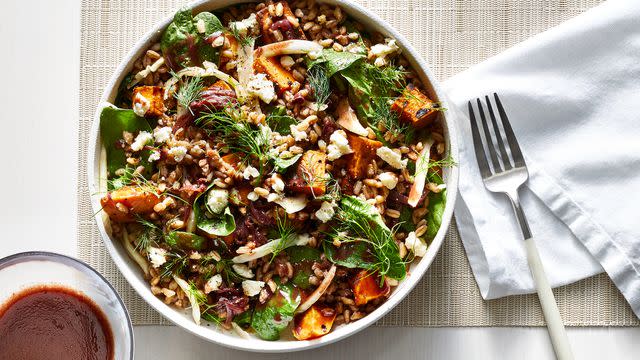
CAITLIN BENSEL
Farro’s nuttiness lends itself well to mixing with fruit, and this pomegranate vinaigrette is both tart and tangy to bring out farro’s toasty notes. Add in caramelized fennel, plus sweet potato, and this is fall in a bowl.
Related: 20 Quick and Easy One-Pan Recipes For Nights When You Don’t Feel Like Cooking
Farro and Squash Salad
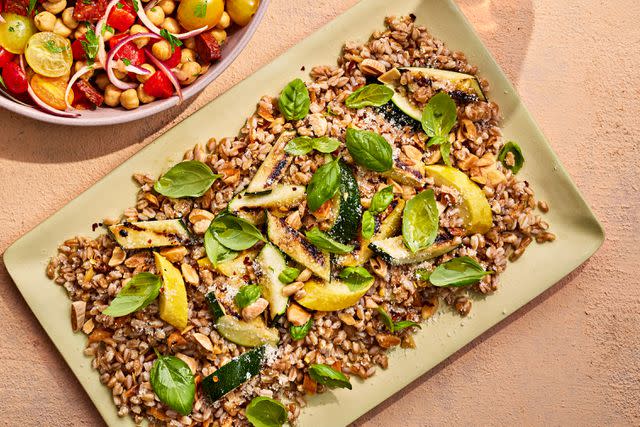
Victor Protasio
Grilled summer squash sits so well on top of farro, and Parmesan and basil add a lovely Italian element. Marcona almonds meld into this salad nicely for a crunch. This is one salad that will go super quickly at the barbecue.
Mushroom and Farro Soup
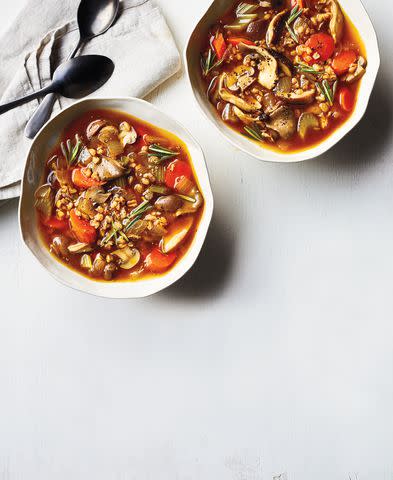
Farro is perfect in soup because it retains its bouncy texture and won’t get mushy. Pairing farro with earthy mushrooms is the ultimate umami move, resulting in a super flavorful, plant-based and naturally vegan bowl of soup that’s oh so comforting.
Salad With Chicken and Crispy Farro
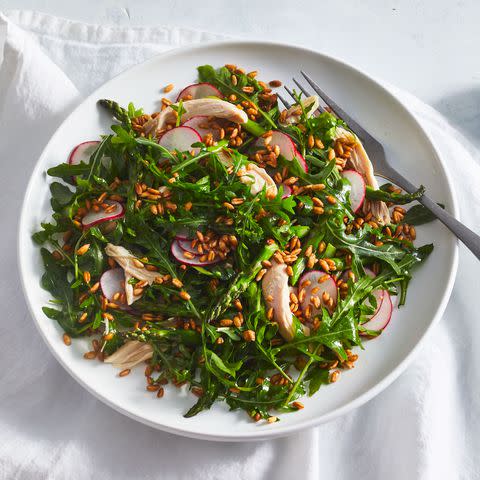
Farro doesn’t always have to be the star of the dish – it’s also a lovely accoutrement. This farro gets crispy under the broiler, popping in your mouth with every bite of salad. Make extra to use as a topper all week!
Farro Salad With Tuna
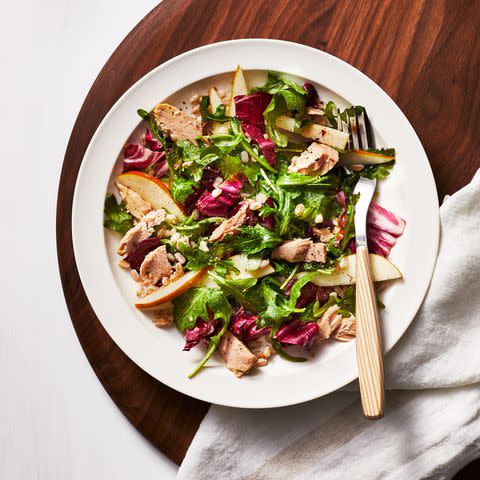
Succulence is the name of the game when seafood and farro meet. This tuna salad is a great, light way to make an elegant meal with a can (or jar) of tuna, and it packs well to eat as a picnic or takeaway lunch.
For more Real Simple news, make sure to sign up for our newsletter!
Read the original article on Real Simple.

